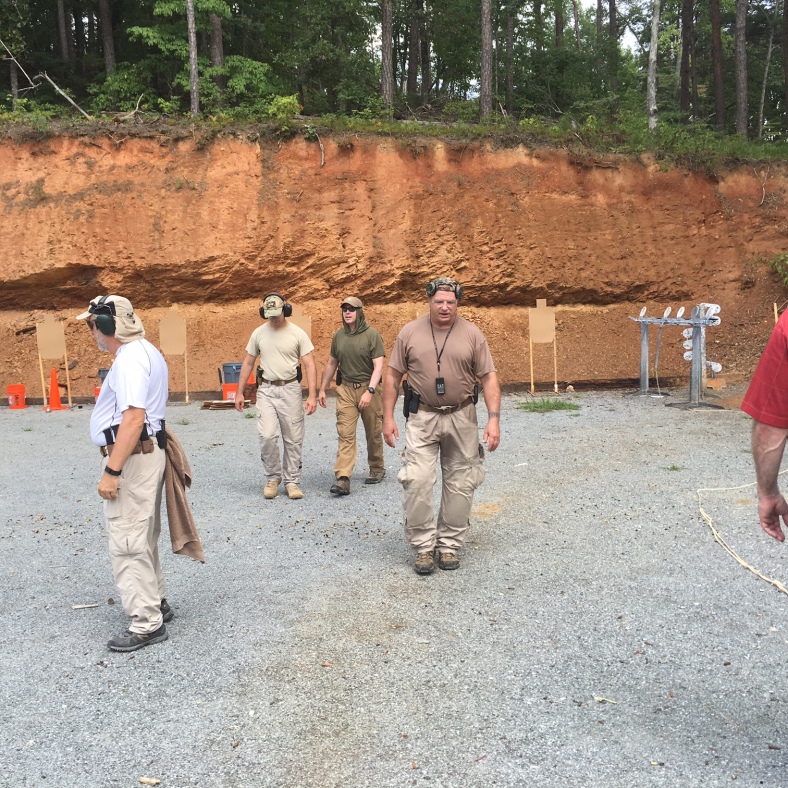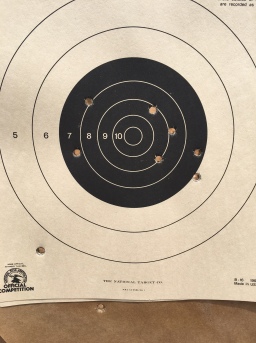I recently spent two days on the range with former SOF, Ranger, “Super” Dave Harrington (SDH) of Combat Speed LLC. Mr. Harrington is a 23 year military veteran (Air Force, Navy, US Army) having spent his final 16 years in US Army Special Forces. He spent two tours as lead instructor at the JFK Special War Center.
I first met SDH back around 2003 at an IDPA match. Since then I’ve trained with Dave numerous times and have hosted training for him. About an even split between pistol only and integrated black rifle and pistol courses. There are very few truly ambidextrous shooters out there, SDH is probably the best. I’ve never seen anyone who can operate a handgun equally both dominate and non-dominate hands. On top of that he can do it across most any handgun platform. Single action (1911), striker fired (Glock, double/single action (Beretta, Sig Sauer), you name it. A lot of people can shoot across platforms, it’s the rare person who is proficient two handed, primary and off handed.
The focus of this two day class was pistols. The class was small with eight shooters from a relatively new shooter to master class shooters. SDH over the years that I’ve known him and have trained with him has refined his instruction to be sharp and focused. He gives no quarter when it comes to safety and operates a hot range. You and you alone are responsible for the safe handling of your firearm and ammunition.
SDH starts the first day with a safety brief. He carries a trauma kit, and identifies anyone who is trained in clearly designates first responder roles including himself.
Training Day 1
Using bullseye targets Dave assesses each shooters ability to make accurate hits on target from 5 yds to 25 yds. As well as right and left hand only (Dave doesn’t believe in strong and weak hand shooting) There may be dominant and non-dominant but “weak” isn’t in the dictionary.

We shot untimed 10 shot groups freestyle at 5 and 10 yds. One handed groups at 5 yards, freestyle groups again at 15 yds and 25 yds. Believe me your ability or inability to group shots will be clearly visible after this drill.
After assessing everyone’s targets (the good, the bad, and the ugly) Dave discussed the principles vs the fundamentals of shooting. Most instructors focus on the fundamentals of shooting (grip, stance, trigger control, sight alignment, breath control, etc…). It’s the principles of shooting that is the focus of Mr. Harrington’s course. Holding, sighting, firing and especially time. What it boils down with guns when it comes to fighting, self defense is your ability to make accurate hits on a target at the speed required to survive the fight. PERIOD.
I won’t go into every drill and spell out each drill here. Over the years the format has evolved for Dave. He has stored in his head so many drills that he can recall on demand as he sees fit for each class on the fly. What I found interesting with this class is that he intentionally alternated between precision drills and fast action (for lack of a better term) drills.
Night shoot
After a very long and hot day on the range we recharged with dinner and awaited nightfall for the low/no light portion of the class. During that time Dave discussed the various hand held light techniques (Harries, Rogers, etc…) and the appropriate use of each as well as the benefits and negatives of handgun mounted lights.
During the night shoot portion we each explored each technique as well as assessed the muzzle flash signatures of both carry and practice ammo and how that affects your vision. Which led into a discussion of visual purple or Rhodopsin which was new to many of us.
I’m not a huge fan of pistol mounted lights and have worked with handhelds for many years. lights mounted on pistols are bulky for daily carry and for me, not practical. I won’t debate the subject but I’ve seen too many people using their gun (both handgun and long gun) as a flashlight with little or no regard to pointing a loaded weapon willy nilly all over the place.
Day 2
Due to the range rules we started day 2 in the classroom discussing dry fire techniques. How you can use inert training rounds to do many of the drills safely in your home that you can do on the range. The value of having a programmable shot time (PACT , and CED). Dave demonstrated several drills including reloads using par times on the timer.
Day 2 Live fire
We ran for 5 hours straight with only breaks for water and mag reloading. Everything on day 2 was built of the foundations laid out on day 1. Again with precision and accuracy at speed being the focus. A lot of distance shooting at 25 yards out to 55 yards. 25 yard bullseyes for score.

25yds with a couple of “El Snatcho” trigger crunches. Lost count and only fired 9.
The day also included a lot of shooting on the move. Again with the emphasis on getting good hits on target. Lateral movement from both directions across an 8 target array. Moving on oblique angles, forward, and rearward all require good stabilization of the human shooting platform. Drills included a reduced version of Ken Hackathorn’s Square Drill. Nearly all the drills on day 2 were on the clock. Some with tough par times Like Dave’s infamous Seible Drill.

Seible Drill
IDPA/USPSA Target (Scored for additional time added)
Par time is based on Master level shooter. Add par time accordingly.
Each string starts with 6rds in the gun with two 6rd reserve magazines
3 x 18 round strings
54 Rounds total
Procedure: Fire 6 rds, reload 6rds, reload 6rds
String 1 (15 sec par time)
25yds
String 2 (12 sec par time)
15yds
String 3 (9 sec par time)
15yds
Dave also ran through a good Bill Wilson drill. A good assessment drill and good drill to incorporate into your practice session
Bill Wilson’s 5 x 5 Skill Test
Target: IDPA 10 yds
Scoring: IDPA Limited Vickers 25 shots total
Start position: Hands at sides, facing target, concealment not required
Procedure:
String 1: Draw and fire 5 shots freestyle
String 2: Draw and fire 5 shots dominant hand only
String 3: Loaded with 5 rounds only, Draw and fire 5 shots, reload from slide lock, fire 5 additional shots freestyle.
String 4: Draw and fire 4 shots to the body, 1 shot to the head.
Skill Ranking: (Bill Wilson’s opinion) Combined time with points down scored
GM: 15 Seconds or less
Master: 20 Seconds or less
Expert: 25 Sec or less
Sharpshooter: 32 Sec or less
Marksman: 41 Sec or less
Novice: 50 Sec or less
Not proficient enough to carry a handgun: Over 50 seconds
I scored 17 seconds and change with 2 points down to score Master.
Final drill for the day at my request. As that it dovetails into sight picture and time.
Accelerate, Decelerate, Accelerate
6 IDPA targets arranged 5 to 25 yards edge on edge with roughly 1 yd separating. So that at 5 yards start position they appear edge to edge except for the range.
12 shots Limited Vickers
Procedure: Fire one shot on each target near to far, then far to near.
The purposes is to shoot fast as possible while maintaining proper sight and recoil management. Accelerate, decelerate, Accelerate.
In the end this was an excellent course. Made challenging by round count (1,400 +/-), Summer heat (90+ 70+% humidity) and duration 18 plus hours of range time.
All skill levels will gain value and excellent practice drills to carry on further skill improvement after the course. Challenging enough for the master class shooters. While this is a great course for competitive shooter this is about principles and skills for fighting. While both are applicable to IDPA, USPSA, etc… Dave’s courses aren’t focused on improving your match skills. Keep that in mind.
If you’re interested in training with “Super” Dave I’ll give you his contact info.









